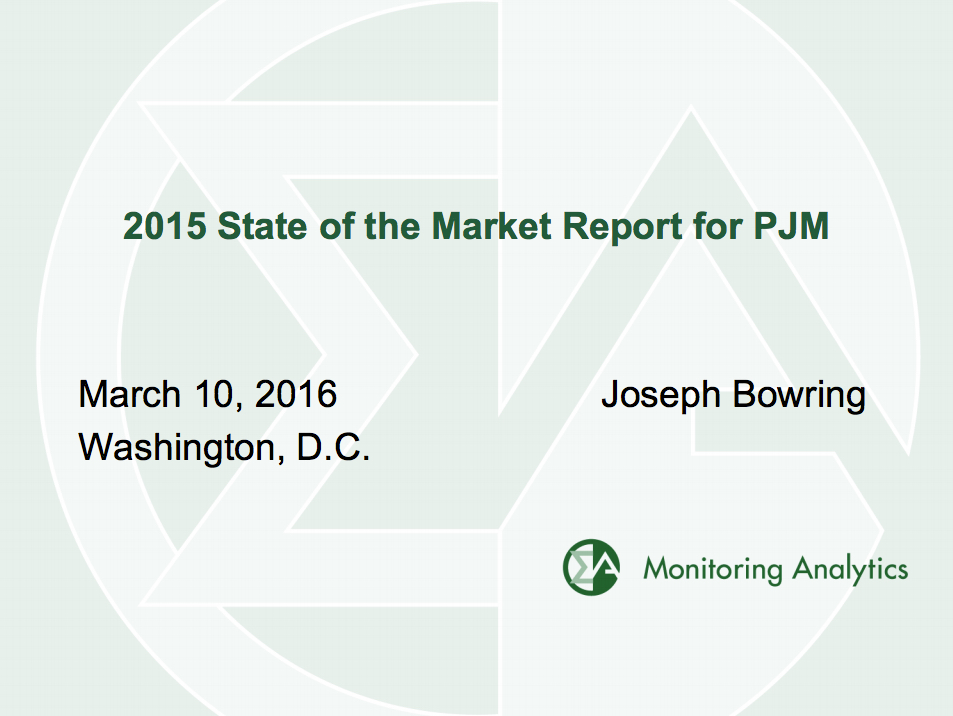The wholesale power markets through which electricity and related products are procured for more than 61 million people across 13 Eastern / Midwestern states and the District of Columbia were found to produce competitive results in 2015, according to Monitoring Analytics, the Independent Market Monitor for PJM Interconnection, the regional grid operator. The independent market monitor’s “State of the Market Report” includes analysis of market structure, participant behavior, and market performance for each of the products and services bought and sold through PJM, the largest grid operator in America.
Dr. Joe Bowring, the president of Monitoring Analytics, said in a news release:
Our analysis concludes that the results of the PJM Energy, Capacity and Regulation Markets in 2015 were competitive.
On the specific subject of the price of electricity, the market monitor found that:
- Energy market prices decreased significantly from 2014 as a combined result of lower fuel prices and lower demand;
- The load-weighted average real-time locational marginal price (LMP) was 31.9 percent lower in 2015 than in 2014, $36.16 per MWh versus $53.14 per MWh;
- While fuel costs contributed to lower prices, the load-weighted average LMP would still have been 21.1 percent lower in 2015 than in 2014 even if fuel costs had not decreased; and
- The load-weighted average price in 2015 was about 20 percent lower than the average of annual prices in all years from 1999 through 2015.
Generally speaking, customers consider low energy prices to be a good thing. In the long run, though, energy market revenues are an essential driver of generators’ net revenue, and net revenue is a key measure of overall market performance as well as a measure of the incentive to invest in new generation. New generation is widely considered to be beneficial because it is overwhelmingly gas-fired, and as such results in lower CO2 emissions than older generation. Therefore, maintaining prices that support new generation is, overall, good. In 2015, net revenues were positive for new investment in gas-fired units, particularly in eastern PJM zones, but market signals continued to be negative for coal and nuclear units.
On the subject of efforts by some to bypass the market, the market monitor is critical. One example cited is the efforts by well-intentioned integrated resource planners to provide non-market subsidies and non-market solutions for issues such as the mix and location of generation resources, the appropriate definition of resource diversity, and which technologies should be favored through exceptions to market rules. The market monitor also acknowledges the temptation by some to provide cost-of-service regulation as opposed to market-driven pricing. Addressing these non-market efforts, the market monitor writes:
[T]he market paradigm and the quasi-market paradigm are mutually exclusive. Once the decision is made that market outcomes must be fundamentally modified, it will be virtually impossible to return to markets. While there are entities in the PJM markets that continue to operate under the quasi-market paradigm, they have made a long term decision on a regulatory model and the PJM rules generally limit any associated, potential negative impacts on markets. That consistent approach to the regulatory model is very different from current attempts to subsidize specific uneconomic market assets using various planning concepts as a rationale. The subsidy model is inconsistent with the PJM market design and inconsistent with the market paradigm and constitutes a significant threat to both. (2015 State of the Market, Vol. 1, pp. 8-9.)
Noting that “the details of market design matter,” the State of the Market Report contains a series of recommended enhancements to existing market rules as well as the a recommendation to implement new rules that the market monitor believes are required to maintain competitive results in PJM markets and for continued improvement in the functioning of PJM markets.
I invite you to view my other posts and sign up to receive future posts via email. I also invite you to follow me on LinkedIn and Twitter, and to contact me via my homepage.


